Self-referential Activity

A diagram about Constructive Self-reference and Activity
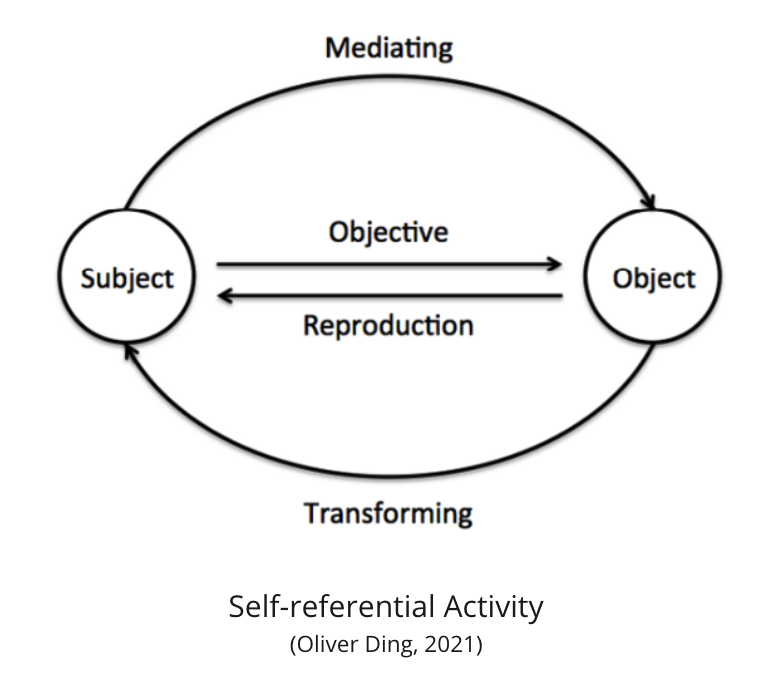
I made the above diagram in 2021 in order to record an notion of connecting the concept of Self-reference and Activity.
On Jan 9, 2022, I wrote a thematic reflection report about my "Activity" thematic space.

I mentioned the idea of "Self-referential Activity" in the "Taste" block.
A thematic space may contain many similar theoretical approaches. If we pay attention to two thematic spaces, then we will focus on similarities between a group of approaches inside a thematic space. However, if we move to the inside of a thematic space, we should pay attention to differences between the same group of approaches. How do we deal with these similarities and differences? It all depends on our tastes which are related to our values, experience, motivation, and more personal aspects. Moreover, tastes are learnable and changeable.
Activity Theory is not a single theory, but a theoretical tradition that has several theoretical approaches. I started learning Activity Theory with the Activity System Model which is really useful for studying organizational activities and collective activities in general. The model offers a series of concepts for connecting theory and practice.

B1 refers to my ideas based on the Activity System Model’s concept and framework. For example, I coined the concept of “Self-reference Activity” to connect Activity Theory and Self-referential System theory. It refers to a special type of activity that can support self-reference development.
Self-referential Systems Theory
The System/Environment notion goes beyond the scope of Activity Theory. We need to adopt theoretical resources outside Activity Theory for creative exploration. For example, Niklas Luhmann’s Social Systems Theory is a self-referential systems theory.
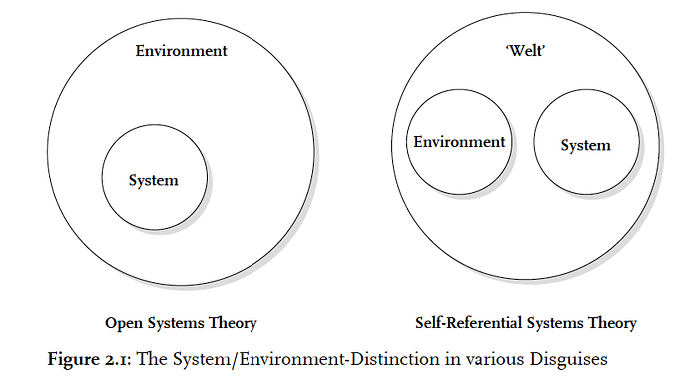
According to Luhmann, there are two types of systems: open system and self-referential system. The above diagram shows the major difference between these two types of systems is the relationship between the system and the environment. For open systems, the system is part of its environment. However, for self-referential systems, the system and environment are exclusive. The term “Welt” refers to a new whole of “system + environment” within the self-referential systems theory.
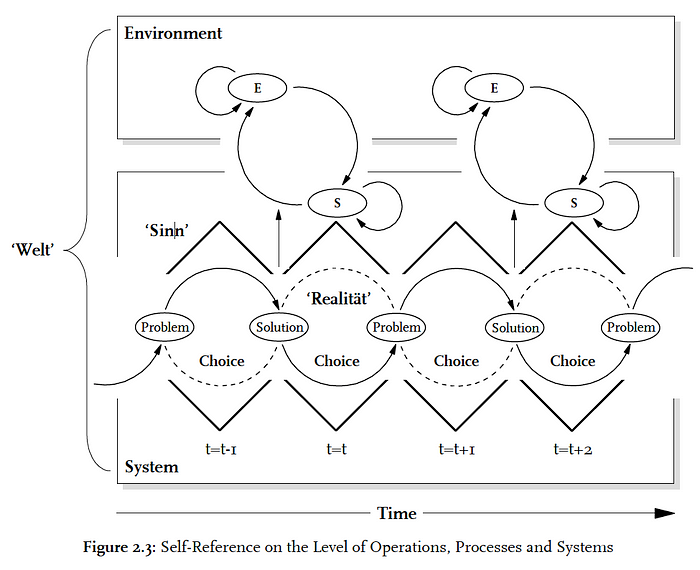
According to Jan-Peter Vos (2002), the actions of social systems can be viewed on three levels of aggregation: the operational level, the level of processes, and the system level. “ On the operational level, self-referential systems are able to create ‘Realität’ or reality by naively commencing in action and asymmetrising the tautology between system and environment in the process…This implies that something can be regarded as real or unreal in the future, dependent on what is regarded as real and unreal in the present past….On the level of processes , the self-reproduction or autopoiesis of operations or ‘Realität’ is dependent on the reproduction of structures or meaning in the sense of what is possible and impossible to regard as real and unreal… On the systemic level , the self-reproduction of ‘Realität’ and ‘Sinn’ is dependent on the reproduction of the system/environment-distinction in the sense of what is regarded as important and unimportant by self-referential systems with respect to the meaningful constitution of their ‘Welt’… In being self-reflexive with respect to their ‘Realität’, ‘Sinn’ and ‘Welt’, social systems have but two forms of observation at their disposal, i.e. tautology and paradox.”
Luhmann’s self-referential system theory is extremely complex. It's hard to connect it with Activity Theory.
However, we can adopt one concept from Luhmann's theory to make a new framework without adopting the whole theory.
The concept of “Self-reference”
I only used the concept of "Self-reference" to connect the concept of "Activity".
What's Self-reference? See the picture below.

The above picture refers to the ancient symbol Ouroboros, a dragon that continually consumes itself. It refers to the concept of Self-reference.
According to Wikipedia,
Self-reference occurs in natural or formal languages when a sentence, idea or formula refers to itself. The reference may be expressed either directly — through some intermediate sentence or formula — or by means of some encoding. In philosophy, it also refers to the ability of a subject to speak of or refer to itself, that is, to have the kind of thought expressed by the first person nominative singular pronoun “I” in English.
Self-reference is studied and has applications in mathematics, philosophy, computer programming, second-order cybernetics, and linguistics, as well as in humor. Self-referential statements are sometimes paradoxical, and can also be considered recursive.
A popular book about the topic is Douglas Hofstadter’s 1979 book GEB (Gödel, Escher, Bach: an Eternal Golden Braid).
There are three types of Self-reference:
- Destructive Self-reference
- Neutral Self-reference
- Constructive Self-reference
The ancient symbol Ouroboros refers to Desctuctive Self-reference. The damage is caused by the self-reference of a system.
Neutral Self-reference doesn’t refer to real damage, but just for the logical game. For example, Dale Thomas wrote the following tweet a few years ago:
This tweet has one hundred and forty characters, seventy-four consonants, thirty-nine vowels, nineteen spaces, five commas, and a full stop.
This tweet doesn’t cause real damage.
I particularly like the third one: Constructive Self-reference. Moreover, I want to apply it to my work and life.
In the past several years, I found that it was so hard to apply it in real-life practice. In contrast, we can frequently use the 2x2 matrix in our daily work and life.
Real Experiences of Using Constructive Self-reference
Most academic theoretical concepts are not useful for practitioners because they are developed for dealing with theoretical issues.
However, some academic theoretical concepts are really useful if they offer brand-new perspectives.
In the past several years, I used the concept of Constructive Self-reference three times in my journey of knowledge engagement.
- 2019: Curativity Theory > Knowledge Curation
- 2022: Project Engagement > Life Discovery
- 2021: Anticipatory Activity System (AAS)
Based on these three examples, I'd like to share the above diagram as a heuristic tool for practitioners.
2019: Curativity Theory > Knowledge Curation
I have been working in the curation field for over ten years. I was the Chief Information Architect of BagTheWeb which was an early tool for content curation (We launched the site in 2010). This experience inspired me to make a long-term commitment to the Curation theme. After having 10 years of various curation-related practical work experience and theory learning, I coined a term called Curativity and developed Curativity Theory which became a book.
The new term Curativity refers to “curating pieces into a meaningful whole” which means general curatorial practice. The reason why I coined the term is that I was not satisfied with the specific view of curation such as “professional curation means art and museum.” I argued that there is a need to redefine “curatorial practice” as a general social activity and a universal experience. In other words, I was calling for an interdisciplinary view of curation or curatorial practice.
From Oct 2018 to March 2019, I wrote a book titled Curativity: The Ecological Approach to General Curation Practice. It is a 615-page Google Doc file. Unfortunately, it was written in Chinese.
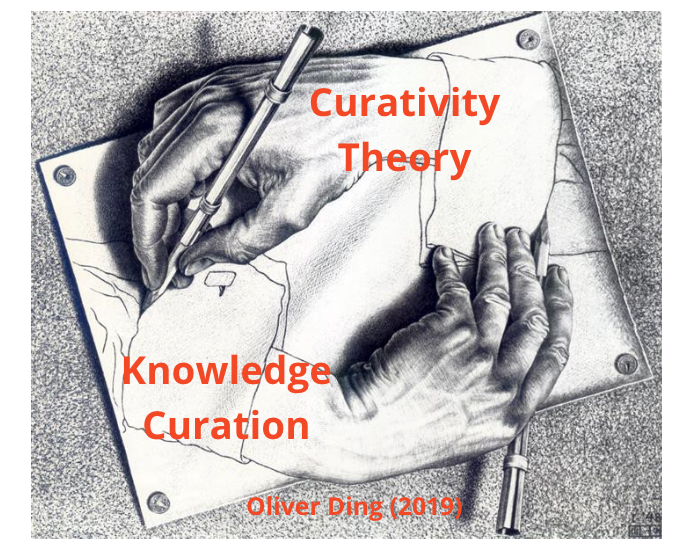
Chapter 7 of the book is titled Curativity Analysis. I chose four fields to test my theoretical concepts and frameworks: Toy Design, Clothing Customization, Family Curation, and Knowledge Curation. These four cases can be considered as the prototype of Curativity Analysis.
In 2020, I needed to decide on a new strategy for CALL (Creative Action Learning Lab). I chose Knowledge Curation as the primary application of Curativity Theory and started the Knowledge Curation Project.
An interesting thing is one of the applications of Curativity theory is Knowledge Curation which can be used to guide the development of Curativity theory. Thus, I roughly make a theoretical self-reference.
However, it depends on the boundary of self. From the perspective of Curativity theory, it is too naive to claim that the pieces and parts are determined by the whole. In fact, Curativity theory embraces the dialectical hierarchy of the pieces-whole relationship. For example, as an application of Curativity theory, Knowledge Curation is a piece while the whole is the Curativity theory. The outcome of Knowledge Curation can be returned to guide the development of Curativity theory.
How do I explore the direction of Knowledge Curation?
The first principle is making new cognitive containers such as diagrams, concepts, and frameworks. For example, I designed the HERO U Framework in June 2020 and applied it to guide the Activity U project in August 2020.
Since then, I have been using the HERO U framework to guide my knowledge curation projects. From August 2020 to May 2022, I wrote 12 books in drafts. This was an amazing experience!
On June 2, 2022, I launched Curativity Theory as a new home for the Knowledge Curation project and other projects.
2022: Project Engagement > Life Discovery
In 2022, I realized that I “USE” the concept of “Self-reference” again for developing the Life-as-Project approach.
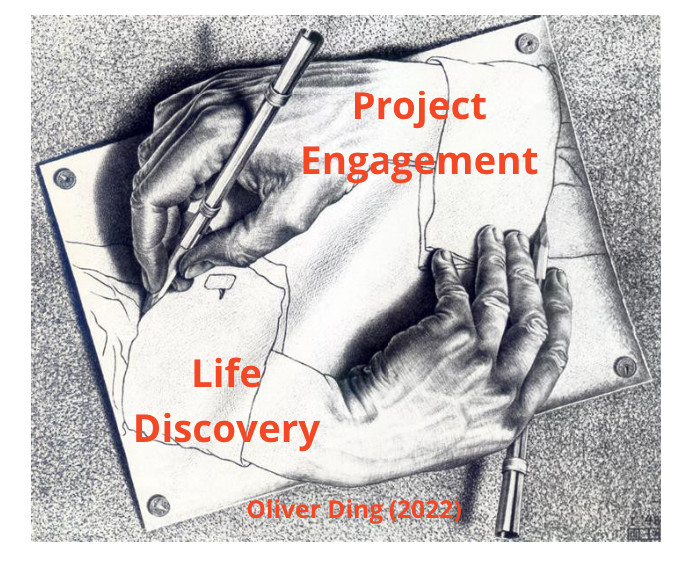
The Life-as-Project approach is an application of my 2021 book Project-oriented Activity Theory. The object of the approach is “Life Discovery”.
In the past six months, I worked on developing the concept of “Life Discovery” by working on three “Life Discovery Projects”. This strategy is just guided by Project-oriented Activity Theory.
I didn’t claim this issue because I intended to develop a new approach called the “Project-centered Approach” which detaches from Project-oriented Activity Theory. However, what I did with the concept of “Life Discovery” is described by Project-oriented Activity Theory.
For me, the Project-centered Approach is inspired by Project-oriented Activity Theory and other theoretical resources.
How did I develop the Project-centered Approach?
- I developed it by working on three Life Discovery Projects.
- I also used the Project-centered Approach to guide my work on three Life Discovery Projects.
This refers to “Self-reference”.
The outcome is a new thing called the “Life-as-Project” approach which connects THEORY and PRACTICE. You can find more details about the “Life-as-Project” approach in Life Discovery: Biography, Journey, Program (and a possible book, Part 1, Part 2).
2021: Anticipatory Activity System (AAS)
In Sept 2021, I developed the Anticipatory Activity System (AAS) framework which was inspired by Activity Theory, Anticipatory System theory, and other theoretical resources.
The AAS framework is perfect for thinking about the complex of “Self, Other, Present, and Future”. For example:
- Sustainable Business Development
- Organizational Strategy
- Startup Studio or Venture Studio
- Technology Choices
- Educational Strategy
- Family Development
- Intimate Relationship
The complex of “Self, Other, Present, and Future” refers to a special type of Activity. In order to understand its uniqueness, I adopted some ideas from the Anticipatory System theory to the AAS framework.
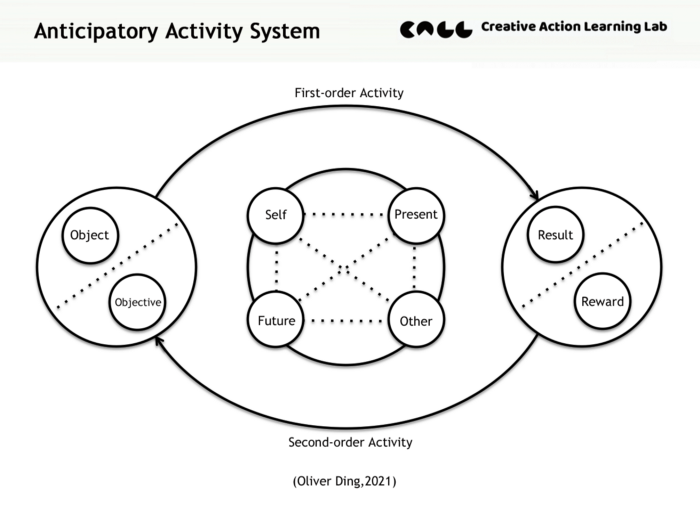
The above diagram is the basic model of the AAS framework. It refers to a special type of Anticipatory System: Activity. The system has one whole and two parts:
- One whole: Anticipatory Activity System
- Part 1: First-order Activity
- Part 2: Second-order Activity
I consider the AAS framework is an application of the “Self-reference” concept.
Why?
First, Anticipatory System is a type of Autopoietic system. Second, the Autopoietic system is also called Self-referential systems.
However, we have to pay attention to the difference between the concept of “Self-reference” and the Self-referential systems because Autopoiesis is the capacity of a system to reproduce the components of which it is composed.
According to Robert Poli, “An autopoietic system does not start from pre-given elements, neither does it assemble them…Autopoietic systems are self-referential systems, means that the system’s relational self-production governs the system’s capacity to have contacts with its environment. Put otherwise, the system’s connection with its environment is no longer a kind of immediate and direct relation between the system and its environment but becomes a reflexive relation, mediated by the self-referential loops that constitute the system itself.” (The Complexity of Anticipation, 2009)
Second-order Activity is defined as a special type of Activity that define Objectives for First-order Activity. In this way, Second-order Activity refers to the activity of self-production.
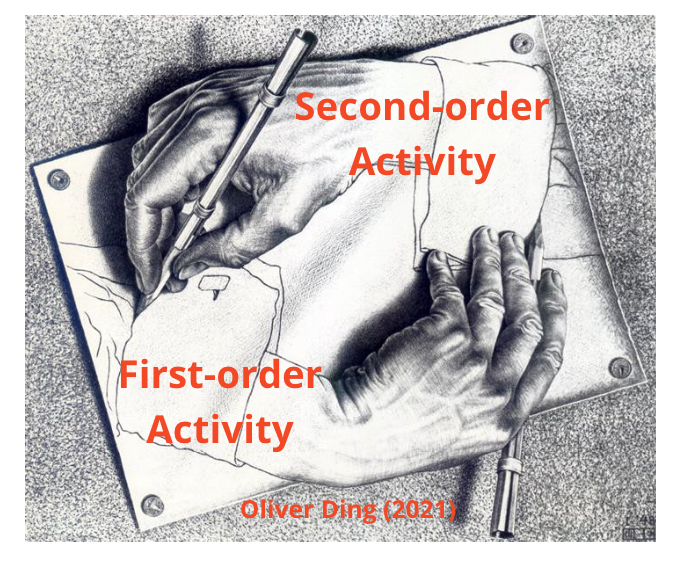
The AAS4LT framework is born from curating insights from both theoretical development and empirical research.
Though most of the ideas are adopted from the Anticipatory Activity System framework and other knowledge frameworks, the whole structure is inspired by an empirical research project about a person’s one-year life transitions.
If you read my articles about iART Framework, you probably know that The Anticipatory Activity System is an expanded version of iART Framework which was born from an empirical research project about an adult development program.
I’d like to call the program SSL which stands for Shaper & Supporter Lab. Anyway, it is just a codename. SSL was founded by a friend of mine in April 2021.
The program was designed with three components: 1) Life Purpose Awareness, 2) Personal OKR Practice, and 3) Peer Review and Feedback. My friend also adopted the Building In Public approach to sharing her goals, challenges, progress, and discussions with others on social media platforms.
My friend started the journey in Feb 2021. In April 2022, we worked on reflecting on her life transition in the past 12 months. In the process of reflection, I realized that she did two activities during the one-year journey.
- Second-order Activity: She spent several months on Life Discovery.
- First-order Activity: Seh started the Shaper & Supporter Lab program as a Developmental Project.
I also observed that she also worked hard on modeling her project and storytelling about her life discovery. This insight inspired me to create the AAS4LT framework. This is an awesome discovery!
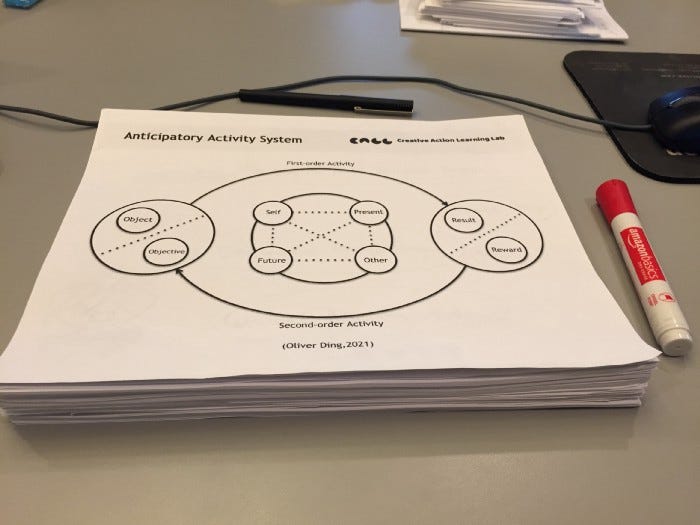
From March 2022 to June 2022, I also worked on the AAS4LT program which is a 1:1 life coaching program for applying AAS to Life Transitions (LT). It considers “Life Discovery Project” as Second-order Activity and “Life Developmental Project” as a First-order Activity.
I used the program to test the AAS framework and developed a framework as an intermediate framework.
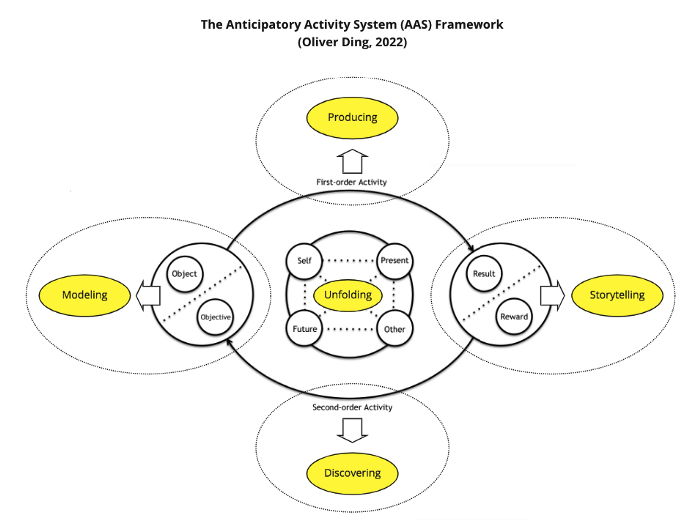
The above diagram is the expanded model of the AAS framework. It highlights five movements to the basic model of AAS.
- Part 1: First-order Activity (Producing)
- Part 2: Second-order Activity (Discovering)
- Whole: Anticipatory Activity System (Unfolding, Modeling, and Storytelling)
The most important movement is Discovering because it refers to Second-order Activity.
Since Anticipatory System is about the future, we need to pay attention to two types of Potentialities.
- Hidden
- Latent
According to Roberto Poli, the entity that is hidden refers to “they are there, only waiting for the triggers able to activate them.” However, “latent determination emerges ‘automatically,’ which means that the context of activation may eventually be provided by the simple passage of time…truly latent components do not exist at all in the entity’s actual state, which may imply that their internal structural determinations have not been formed.”(The Complexity of Anticipation, 2009)
I use the “Unfolding” movement to refer to the process of “the simple passage of time” in order to highlight the “latent” part of the system. This is also the reason that I adopted the “Slow Cognition” method to design the AAS4LT program.
Life Discovery Project is designed for discovering hidden entities and latent entities of Anticipatory Activity Systems.
Self-referential Activity
The Self-referential Activity diagram uses major concepts of Activity Theory and represents a specific configuration of these concepts.
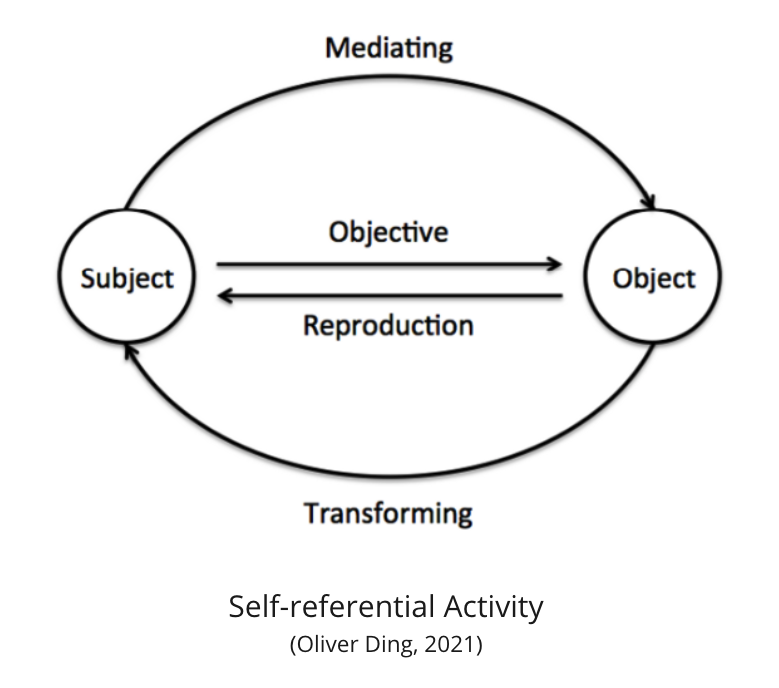
- Subject and Object
- Mediating
- Objective
- Reproduction
- Transforming
Subject and Object are two primary concepts of Activity Theory because Activity is a bridge between Subject and Object. All activities are influenced by the attributes of subjects and objects.

Mediating Actions refer to the concept of Mediation in Activity Theory. Since the theoretical traditions have different versions, the concept of Mediation also has different versions.
The foundation of Activity Theory and CHAT, in general, is Lev Vygotsky’s idea of “mediated action”.
Vygotsky claimed that human action and psychological functions are mediated by tools which refer to technical tools that work on objects and psychological tools that mediate the mind and environment. The idea of “mediated action” is usually represented by a triangle that contains three elements: subject, mediating artifact/tool, and object.

Object and Objective are about the concept of Object in Activity Theory.
According to the founder of Activity Theory A. N. Leontiev, “Separate concrete types of activity may differ among themselves according to various characteristics: according to their form, according to the methods of carrying them out, according to their emotional intensity, according to their time and space requirements, according to their physiological mechanisms, etc. The main thing that distinguishes one activity from another, however, is the difference of their objects. It is exactly the object of an activity that gives it a determined direction.” (1978, p.98)
However, the concept of Object has a different meaning in the Activity System Model which was developed by Yrjö Engeström with the above triangle diagram. According to Kaptelinin and Nardi (2006), “For Leontiev, the object (predmet) of activity is an object of activities carried out by individuals, either collectively or individually, and is related to motivation. For Engeström, the object, introduced through the ‘subject — object’ distinction — that is, as objekt — is the object of collective activities. The object is defined as ‘the raw material’ or ‘problem space’ at which the activity is directed and which is molded and transformed into outcome…’ ” (2006, p.142–143)
Reproduction refers to the Reproduction of Activity. The change of Object will lead to a new Objective which lead to a new Activity.
Transforming refers to the Transformation of Subject. Some changes of Objec will lead to the change of Subject.
How to use the Self-referential Activity framework?
There is a part-whole relationship in an Activity or a project. According to Andy Blunden, "An activity or project is an aggregate of actions... the activity is generally a precondition for any of the component actions."

- Part: actions
- Whole: activity
If you want to apply the Self-referential Activity framework in your real-life activities, you should pay attention to the Part - Whole relationship.
- You can use a particular Action to generate other Actions
- You can use a particular Action to change the whole Activity
A great example of Self-referential Activity is making internal tools that will change the whole Activity because the internal tools are mediation.
